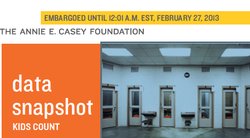A new report finds youth incarceration is down nationwide, but California still has a fairly high rate: 271 per 100,000 young people. That’s the 11th highest in the country. We take a look at how those numbers break down in San Diego and highlight how City Heights is tackling the problem. | Video Credit: Nicholas McVicker and Brian Myers
By Megan Burks
Click here to listen to a KPBS Midday Edition interview with Probation Chief Mack Jenkins, National Conflict Resolution Center Coordinator Bridget Lambert and Deputy District Attorney Michele Linley.
City Heights Residents Tackle Youth Incarceration Rates, Aired on KPBS Radio Feb. 28
[audio:http://speakcityheights.org/wp-content/uploads/2013/02/JUSTICE_Radio.mp3]
A report released Wednesday suggests there’s a sea change in the way the nation handles juvenile crime. The number of kids behind bars has decreased more than 40 percent since 1995. San Diego rates are also trending down.
 Click for report |
But the United States still leads the industrialized world in the rate at which it locks up youth. California is among the top 12 states for youth incarceration, with a rate of 271 per 100,000 young people.
The report, which was put out by the Annie E. Casey Foundation and advocacy group Children Now, covers all youth under 21 in detention in prisons and group homes.
San Diego County Probation Chief Mack Jenkins said only about 1,000 youth inmates are under state supervision – the rest are supervised at the county level.
In San Diego, 688 teens are in custody at the county’s five juvenile facilities, compared to 3,600 who are out in the community on probation. Jenkins said just 20 percent of the youth who end up in the county’s juvenile justice system are put behind bars.
“We follow very strict criteria that’s outlined in the California Welfare Institutions Code,” Jenkins said. “And we have a screening tool that we employ to make sure that only those kids who need to be are ever booked into juvenile hall.”
Despite the downward trend in youth incarceration, some San Diego residents remain concerned.
African-American and Latino teens are still overrepresented in juvenile detention facilities. That’s a big issue for the diverse neighborhood of City Heights.
There, residents involved with community nonprofit Mid-City CAN and the Wellness and Restorative Practices Partnership are trying to bottleneck what they call the cradle-to-prison pipeline.
“Unfortunately, it starts with one arrest, but it soon generates into a pipeline and it eliminates a lot of opportunities for these kids,” said Bridget Lambert, an outreach coordinator for the National Conflict Resolution Center. “If we can catch it at this early stage, it gives them this opportunity to get out of the pipeline.”
Lambert is working with community members and law enforcement on a pilot program that catches youth post-arrest.
The strategy is called restorative conferencing. Instead of getting their sentence from a judge, youth who commit non-violent crimes have the opportunity to meet with their victim – the owner of the car they broke into or the principal of the school they tagged.
The victim, the offender and a mediator then decide on the punishment – something like community service or anger management classes. If the teen complies, his or her record is cleared.
Lambert said she’s had five cases referred to the program, which got off the ground last year.
On the other side of City Heights, Mid-City CAN resident leader Deko Hussein is working on a similar pilot program. It intervenes when youth enter the court system.
“It’s knowing that I did something to someone, rather than just, ‘Hey, a prosecutor puts me in jail and at the end of the day, I’m just waiting to get out of jail and do the same crime again,’” said Hussein, a San Diego State University student.
Her group is working with the county’s probation and district attorney’s offices.
Probation Chief Jenkins said he supports the effort. He credits similar diversionary programs such as Teen Court, which employs students to prosecute and sentence their classmates, with recent declines in the number of youth offenders coming through his doors.
“We’ve really been out in front, if I may, on the issue of early intervention and diversion from a justice system collaboration, as well as community partners,” Jenkins said.
But Jenkins said there are some youth who won’t benefit from diversion programs and need to be in custody.
Both Hussein and Lambert said their approach isn’t too soft on crime, but actually more effective than traditional courses of action.
“We’re not saying that kids don’t need to be punished, they don’t need to be held responsible for something that they’ve done,” Hussein said. “But we’re saying that the method of just punishing a kid has been tried and it’s not working. It’s not working because recidivism rates are really high.”
In 2011, 31 percent of youth on probation in San Diego County reoffended. Restorative conferencing programs throughout the nation report recidivism rates in the single digits.
KPBS’ Alison St John, Patty Lane and Peggy Pico contributed to this story.
[Disclosure: Mid-City CAN receives funding from The California Endowment, which also funds Speak City Heights. The Endowment also funds the Wellness and Restorative Practices Partnership. Speak City Heights operates as an independent news collaborative.]
